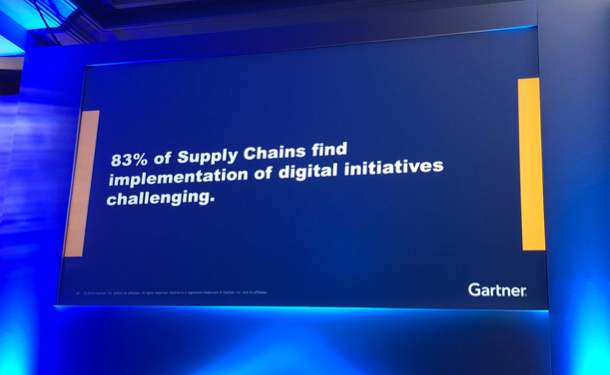Savi attended the Gartner Supply Chain Executive Conference again this year in Phoenix. It was exciting to be at the intersection of smart people in the industry, clients that inspire, and technology innovation. One thing I’ve noticed at supply chain conferences over the last 10 years is that “digitization” has been like the weather —everybody talks about it but nobody does anything about it!
But, this year was different. I saw many proof-of-concept examples and promising case studies on how leading manufacturing companies and large 3PLs are using digitally extracted data to improve supply chain performance.
Gartner 2019 SCC: A New Era – Convergence of the Digital and Physical Supply Chain
I was pleased to present a case study with our forward-thinking customer Corning, Inc. who shared how Internet of Things (IoT) and real-time visibility enabled them to improve delivery performance. Corning used IoT sensors, historical and real-time data with our analytics to test which lanes, carriers, and packaging produced the safest transportation option so they could create optimal shipping profiles for different shipping scenarios. Corning has a long, storied history of innovation, so it’s no surprise that they intend to extend that legacy to include their supply chain.
Why Do We Care About Digitization?
While presenting our customer’s case study, Corning’s Van Bicknell answered why companies are so motivated to digitize their supply chains:
“Digital supply chains can reduce supply chain process costs by 50%, reduce procurement costs by 20% and increase revenue by 10%.”
Beyond Supply Chain Digitization Challenges
The trek toward digitalization of supply chains has been undeniably slow. We heard at Gartner that 83% of supply chains find the implementation of digital initiatives challenging. So, what contributes to the lack of progress on digital initiatives?

According to Gartner analyst James Lisica, 50% of Chief Supply Chain Officers say lack of a roadmap is the biggest roadblock to digitalization.
Luckily, some companies are finding a way forward. As supply chain leaders partner with their IT colleagues to test new technology, everyone realizes that it starts with the quantity and quality of your data.
Next, you need to have enough storage and processing power to handle the utterly massive amount of data that supply chain processes and operations generate—hence the need to partner with IT. You need a platform to cleanse, order and normalize the data so that the new technology can use it. That’s where some touted artificial intelligence (AI) capabilities.
But is artificial intelligence utilizing a few algorithms to determine whether data is structured or unstructured, what the data format is, when timestamps are out of order, if a reported time is in UTC or the local time zone?
Analytics & Automation for Pattern Recognition & Alerts
Once supply chain data is collected, stored and useable, new technology can synchronize multiple demand and supply data streams or show trends and alert on exception conditions.
Most of the case studies at Gartner 2019 focused on implementations that used new technology and methods to use the pattern recognition abilities of modern software to free humans from ledger checking and let the machines do it for them. They also set limits so the software alerts when a human should be notified. I noticed a few are entering the next phase of digitization—using true artificial intelligence to continuously assess current conditions against all existing data and automatically select best-fit algorithms to predict what will happen before it does happen.
Industry 4.0 Momentum
I expect next year’s conference will see an acceleration of the convergence from physical to digital supply chains. I don’t expect it to wrap up in a year or even five years, but the journey to an end-to-end digitized supply chain seems to have some momentum! Savi looks forward to providing the hardware and software solutions necessary for real-time visibility and the predictive and prescriptive analytics that will lead supply chains more rapidly to Industry 4.0.
I’m excited that we’re seeing progress towards a more agile, responsive supply chain. Astute supply chain executives realize that if your supply chain cannot deliver on its brand’s promise, you cannot deliver great customer experiences.

